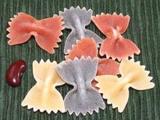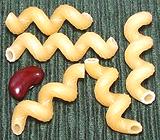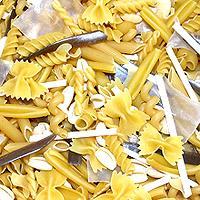
SAFARI
Users
-

General & History
No, Marco Polo didn't bring pasta back from China. It was well known in Italy before he left for the Orient.
-

Pasta Sauces and Serving - Overview
-

Buying, Storing and Cooking Pasta
-

Overview of Types
-

Making Fresh and Stuffed Pasta
-

Selecting Italian Pasta Shapes
We have divided shapes into categories due to browser performance issues.
- Links - to pasta sites.
General & History
 The origin of pasta and noodles in Italy is obscure, but they most
certainly weren't brought back from China by Marco Polo. Pasta was well
known in Italy before he left on his voyage. For details on this history,
see our Pasta & Noodles overview page.
The origin of pasta and noodles in Italy is obscure, but they most
certainly weren't brought back from China by Marco Polo. Pasta was well
known in Italy before he left on his voyage. For details on this history,
see our Pasta & Noodles overview page.
The making of true pasta requires a particular hard, high protein (but low gluten) wheat: Triticum durum alt Triticum turgidum var. durum. It is this hard wheat that is responsible for the unique color, drying properties, cooking properties, taste and texture of true pasta - and the ability to be rolled and extruded into the myriad simple and complex shapes we are accustomed to.
It is true that in Central Europe, pasta-like shapes are often made from bread wheat flour, or even "all purpose" wheat flour. These "pasta" shapes differ substantially in texture, flavor and ability to hold shape from durum wheat pasta.
Italy is unable to grow enough durum wheat to meet its demand for quality pasta. Formerly much was imported from Russia and Ukraine, but Communist central planning destroyed the agriculture of the region, so Italy shifted its trade to North America, particularly Canada.
The Middle East produces about as much durum wheat as Europe and North America combined, but nearly all is used to make bulgur (parboiled wheat) and flat breads (durum can't make light European style breads).
Fresh, Dried and Colored Pasta
 Neither dried nor fresh pasta is superior to the other, nor are they
quite interchangeable. They are different and used differently, and with
different saucing. Dried is firm and chewy, fresh is tender and delicate.
Fresh has the additional role of being used for more kinds of stuffed
pasta than dried can be.
Neither dried nor fresh pasta is superior to the other, nor are they
quite interchangeable. They are different and used differently, and with
different saucing. Dried is firm and chewy, fresh is tender and delicate.
Fresh has the additional role of being used for more kinds of stuffed
pasta than dried can be.
Dried Pasta:
Southern Italy is the home of dried pasta, having had the right humidity and reliable breezes to allow outdoor air drying, before modern indoor drying became practical. Fresh pasta is made in the south, but much less often than in the north.Italian dried pasta is made out of durum wheat semolina (coarse flour) and water. By Italian law no other ingredients may be used. In North America, some vitamins may be mixed in for "enriched" pasta.
There are two styles of dried pasta: that extruded through modern teflon dies and that extruded through traditional bronze dies. Pasta made with bronze dies has a rougher texture and a whiter appearance than that made with teflon dies. Teflon die pasta is very smooth and distinctly yellow in color.
Pasta chefs prefer bronze die pasta because it cooks more evenly and the rough surface grips sauces better. Factory managers prefer the teflon dies, because the extrusion process is much faster and stresses the machinery less. Most retailers also prefer the teflon die product because its shiny surface is more attractive at point of sale. Personally, I have a slight preferance for the teflon die pasta.
Fresh Pasta:
Northern Italy uses more fresh pasta than Southern Italy, but it no longer dominates even there. It is a hassle to make, so it's usually reserved for special dishes and special occasions.Fresh pasta is usually made from softer wheats, though some durum semolina can be mixed in, and some is made with just durum, but that takes a lot of strength to work with.
In the south, some fresh pasta is made with just flour and water, but in the north it is almost always made with flour, eggs, salt and water. If it is to be used for stuffing, as in ravioli, a little milk is sometimes added.
Colored Pasta
should be made only with natural colors. "Tricolor" uses tomato and spinach for color. Where more colors are desired tomato, spinach, turmeric, red beet, basil, carrot and squid ink are used in powdered form at about a 1.5%. except tomato which may be around 3%. The colorant does flavor the pasta but not strongly. Use a simple butter or oil dressing on these to preserve color and flavor.Italian Pasta Shapes
 Until near the beginning of the 20th century, dried pasta, or
macharoni, meant vermicelli and other spaghetti-like forms, and perhaps
a few cut flat forms like fettuchine. The reason for this parsity of
shapes was that only long thin pasta could be hung out to dry in the open
air. Other factors were the difficulty of making dies that would produce
shapes (drilling round holes was easy) and limitations of the presses
used to extrude pasta through the dies.
Until near the beginning of the 20th century, dried pasta, or
macharoni, meant vermicelli and other spaghetti-like forms, and perhaps
a few cut flat forms like fettuchine. The reason for this parsity of
shapes was that only long thin pasta could be hung out to dry in the open
air. Other factors were the difficulty of making dies that would produce
shapes (drilling round holes was easy) and limitations of the presses
used to extrude pasta through the dies.
Drying tunnels replacing the open air racks made shapes more feasible,
as they could be dried on screens as well as hanging on racks.
Mechanization of the presses and advances in cutting shaped dies also
contributed greatly to the explosion of pasta shapes.
Choosing Shapes:
There are several factors in choosing an appropriate shape:- Sauce: How well will the sauce cling to it? For light sauces, long thin strands are fine. For chunky meat sauces short shapes or wide flat ribbons are much better.
- Consistency: How well will the size and shape of the pasta match the size and shape of other ingredients?
- Appearance and Variety: Do you want a decorative shape as a feature, or a plain shape so other ingredients are featured?
- Availability: All the shapes photographed for these pages were available in Los Angeles - but other regions may be more impoverished, shape-wise.
Note on sizes: For string pastas like linguini and fettuchini there is some variation in size among manufacturers, particularly for lengths but also diameters and thickness - but they're all usually pretty close. There is a lot of size variation with the shorter shapes.
Where size goes really bananas is with the "artisan pastas", easily identifiable by their whitish "bronze die" color and high prices. Artisan pastas often use the standard names and shapes but make them HUGE.Links
- P2 - Pasta & Shapes - Cook's Thesaurus
- P4 - Pasta Shapes - Archimedes' Laboratory
- P5 - Pasta Shapes - Pasta it
- P6 - Pasta History - The History of Macaroni Clifford A Wright.
- P7 - Pasta History - Concetta's Cucina
- P10 - Oldest noodles unearthed in China - BBC News




 Long Pastas
Long Pastas Short Shapes
Short Shapes Tiny Soup Shapes
Tiny Soup Shapes